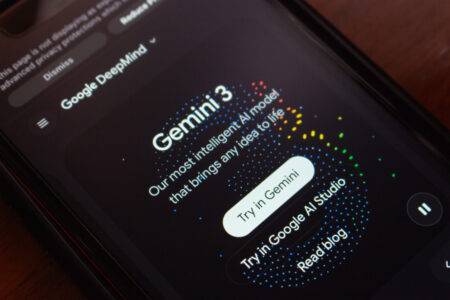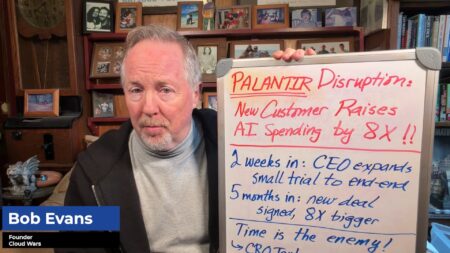As the already-extraordinary growth rate of the enterprise cloud accelerates, can two of the world’s most valuable and influential companies—Microsoft and Google—compete not only fiercely enough to win tens of billions in revenue but also collaboratively enough to keep peace with their major partners?
(On my Cloud Wars Top 10 weekly rankings, Microsoft is #1 and Google Cloud is #4.)
That question of balance was one of the first things that popped into my head when I heard about the launch of Workspace, Google’s ambitious entry into the booming segment for digital collaboration tools.
From the blog post announcing the launch of Workspace, this excerpt gives you an idea of the staggering ambition Google Cloud has for its digital Swiss Army knife:
That solution is Google Workspace: everything you need to get anything done, now in one place. Google Workspace includes all of the productivity apps you know and love—Gmail, Calendar, Drive, Docs, Sheets, Slides, Meet, and many more. Whether you’re returning to the office, working from home, on the frontlines with your mobile device, or connecting with customers, Google Workspace is the best way to create, communicate, and collaborate.
Of course, every company wants its new products to be roaring successes so it’s no surprise to see the soaring prose. But “everything you need to get anything done” scores pretty danged high on the Ambition-O-Meter—I mean, if Workspace offers everything for anything, then nothing else is needed…right?
This is where my question comes in about ambition versus collaboration, and the need for massive companies like Google and Microsoft to work very hard to strike that balance not only for themselves but also for their partners.
Balancing self-interest and adjacent interdependencies
Here’s what I mean:
- From the day Google launches Workspace, it will have billions—not millions, but billions—of users in this vital personal-productivity end of the market. Heck, in early 2016, Google said it had 7 products with more than a billion users, and in June of 2019 that rose to 9 products used by more than 1 billion people. Of course, not all of those 9 are in Workspace—but at least of them are: Mail and Drive. Does that leave a lot of room for partners to grow and thrive in the personal-productivity space?
- At the top end of the SaaS applications market, Google Cloud has been aggressively developing a series of what it calls AI-driven industry-specific solutions. But my guess is that customers will look at them as very powerful and valuable enterprise apps that are becoming very valuable in the digital economy. Regardless of whether these new apps/solutions cross over in any way into traditional apps like ERP, HCM and CRM, the perception among the major application players could well be that they do. But that’s free-market capitalism, right? And if Google can deliver unprecedented types of value to highly demanding corporate customers, why wouldn’t it?
- At the same time, Google Cloud is eager to have corporate customers move their “traditional” enterprise apps from SAP and Oracle on-premises environments into Google Cloud IaaS. And by all accounts, Google Cloud is growing very nicely in that segment, and SAP has become a great partner in helping convince big corporate accounts to move their on-premises SAP workloads to Google Cloud. But—what if, as Google Cloud rolls out more and more of these modern and sophisticated AI-driven industry-specific solutions, SAP begins to say, “Wait a minute—if Google Cloud is starting to compete with my SaaS apps, then I’m sure as heck not going to advise my customers to move their traditional SAP workloads to Google infrastructure!”
A look across the competitive landscape
Here’s a list of some of my recent analyses about who’s doing what in this incredibly important space:
- Google Launches New Era in Cloud with AI-Powered Industry Solutions
- Look Out, Google and SAP: Microsoft Jumping into Red-Hot Industry Solutions
- Google and SAP Fusing Cloud and AI in Next-Gen Apps for Industries
- SAP’s Secret Weapon: Month-Old Industry Cloud Already ‘Growth Driver’
- Hey Microsoft: Google Cloud Is Pushing You Out as SAP’s #1 Cloud Partner
- SAP Will Battle Microsoft & Google for Customer Control, Says CEO Christian Klein
- Google Cloud Helps Drive Triple-Digit Online Growth at Lowe’s
- Microsoft Top 10 Customers for Digital Transformation: the Satya Nadella Touch
Microsoft faces a challenge very similar to Google Cloud’s
Microsoft is in a very similar situation.
- In the same market as Workspace, Microsoft is pushing its Teams suite very aggressively.
- At the high end, Microsoft has built its Dynamics 365 enterprise SaaS apps into a business that will do about $2 billion in revenue this calendar year. It customers and/or SAP and Oracle perceive Microsoft to be competing with them in the enterprise-apps space with Dynamics 365, just how eager will SAP and Oracle be to advise customers to move on-prem workloads to Azure?
- On top of that, as I wrote a couple of weeks ago in Look Out, Google and SAP: Microsoft Jumping into Red-Hot Industry Solutions, Microsoft is building out a large and fast-growing set of solutions and data capabilities to address the need among customers for more vertical-market expertise. Satya Nadella and his company are of course free to do that, but how directly will those industry-specific efforts clash with, for example, SAP’s new Industry Cloud? Will that enhance or hamper the close relationship between Microsoft and SAP
Final Thought
Ambition and big vision and aggressive execution are wonderful things. They make companies bold and assertive, they force a level of focus that more-passive approaches don’t need, and they contribute to a relentlessly competitive environment that delivers huge value to customers and also to the vendors with the best ideas and approaches.
But there comes a point where interdependent adjacencies and unwavering self-interest collide.
And I think that unless Microsoft and Google Cloud are very thoughtful about how they proceed in these wildly disruptive and high-growth times, they will find more and more partners becoming much more self-interested as well.
RECOMMENDED READING
Look Out, Google and SAP: Microsoft Jumping into Red-Hot Industry Solutions
SAP Thumps Salesforce, Oracle, Adobe in B2B Digital Commerce: IDC
Larry Ellison’s Next Trick: Oracle Cloud and Nvidia Unleash Mainstream AI
Can Oracle Snatch Trillion-Dollar Hybrid Market from Microsoft and IBM?
Top 5 Cloud Vendors for Q4: #1 Microsoft, #2 Amazon, #3 Salesforce, #4 Google Cloud, #5 SAP
SAP CFO Shoots Down Larry Ellison Claim of Oracle Snatching SAP Customers
The Audacious Larry Ellison Flips Oracle Cloud Strategy Upside-Down
Market-Cap Madness: ServiceNow at $90 Billion Halfway to Oracle and SAP at $180 Billion
Salesforce’s Marc Benioff Dishes Tough Love to Passive CEOs: ‘Get Out of Paralysis!’
Best Software Acquisition of All Time Was Salesforce Buying Tableau: Marc Benioff
What Did Oracle, Salesforce and SAP All Scrap But Workday Just Revived?
Disclosure: at the time of this writing, Google Cloud and SAP were among the many clients of Cloud Wars Media LLC and/or Evans Strategic Communications LLC.
Subscribe to the Cloud Wars Newsletter for in-depth analysis of the major cloud vendors from the perspective of business customers. It’s free, it’s exclusive and it’s great!








